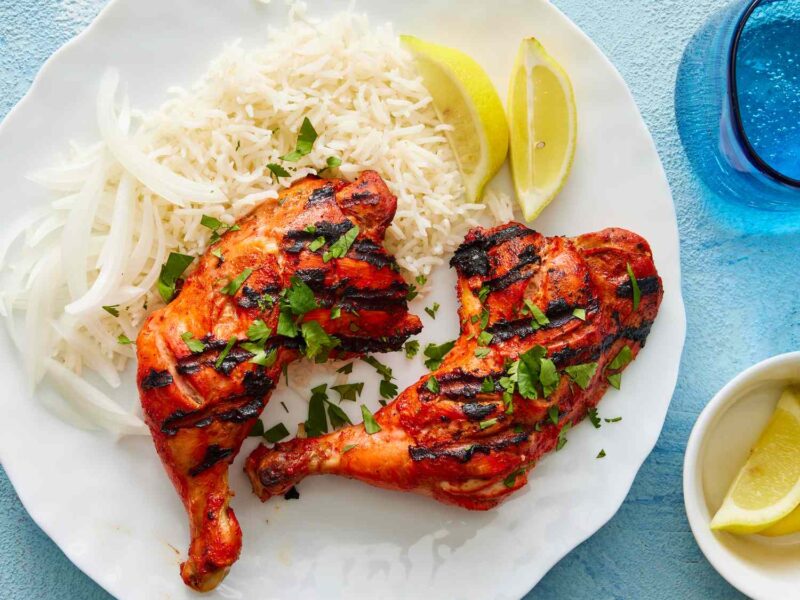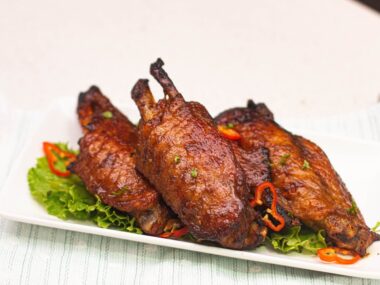Tandoori chicken holds a revered place in Indian cuisine, celebrated for its bold flavours, tender texture, and vibrant colours. This iconic dish originated in the Punjab region of India and has since gained popularity worldwide.
Tandoori chicken is renowned for its distinctive preparation method, where chicken pieces are marinated in a blend of yoghurt and spices, and then cooked in a tandoor, a traditional clay oven. This essay delves into the rich history, traditional preparation, and culinary allure of tandoori chicken, offering insights into its ingredients, cooking techniques, and cultural significance.
History and Origins
The roots of tandoori chicken can be traced back to the culinary traditions of the Punjab region, which spans parts of India and Pakistan. The dish is believed to have originated in the early 20th century, with its creation credited to Kundan Lal Gujral, a restaurateur in Peshawar, now in Pakistan.
Gujral experimented with marinating chicken in yoghurt and spices to tenderize and flavour the meat before cooking it in a tandoor oven. The result was a succulent and aromatic dish that quickly gained popularity among diners.
Ingredients and Marination

Central to the preparation of tandoori chicken is the marinade, which imparts the dish its distinctive flavour profile. The marinade typically consists of yoghurt, which tenderizes the chicken while adding a creamy texture, and a blend of spices that infuse the meat with layers of flavour. Common spices used in tandoori chicken marinade include:
- Ginger and Garlic: Fresh ginger and garlic paste adds pungent and aromatic notes to the marinade, enhancing the overall taste of the dish.
- Chili Powder: Ground chilli powder lends heat and intensity to the marinade, giving tandoori chicken its characteristic spicy kick.
- Turmeric: Turmeric not only imparts a vibrant yellow hue to the chicken but also offers earthy and slightly bitter undertones.
- Cumin and Coriander: Ground cumin and coriander seeds contribute warm, nutty flavours to the marinade, complementing the other spices.
- Garam Masala: A blend of aromatic spices such as cardamom, cinnamon, cloves, and black pepper, garam masala adds depth and complexity to the marinade.
In addition to these spices, lemon juice or vinegar may be added to the marinade to tenderize the chicken further and balance the flavours.
Preparation and Cooking
Once the chicken is thoroughly coated in the marinade, it is left to marinate for several hours or overnight, allowing the flavours to penetrate the meat fully. Traditionally, tandoori chicken is cooked in a tandoor, a cylindrical clay oven heated by charcoal or wood fire. The intense heat of the tandoor sears the marinated chicken quickly, creating a crisp outer crust while sealing in the juices, resulting in tender and succulent meat.
Alternatively, tandoori chicken can be cooked using modern kitchen equipment such as a grill or oven. When grilling tandoori chicken, it is essential to cook it over high heat, either on a gas grill or charcoal grill, to replicate the charred and smoky flavour imparted by the tandoor. In an oven, tandoori chicken can be cooked at a high temperature, preferably on a wire rack set over a baking sheet to allow air circulation and even cooking.
The chicken is typically cooked until it is charred and slightly blackened on the outside, with the meat cooked through and juicy on the inside. Garnished with fresh cilantro leaves and lemon wedges, tandoori chicken is often served hot, accompanied by naan bread, mint chutney, and sliced onions.
Cultural Significance and Serving
Tandoori chicken holds cultural significance beyond its culinary appeal, serving as a symbol of celebration and hospitality in Indian cuisine. It is commonly served at festive occasions such as weddings, festivals, and family gatherings, where it is enjoyed as a centrepiece dish alongside other traditional delicacies.
The communal act of sharing tandoori chicken with loved ones fosters a sense of togetherness and conviviality, reinforcing the importance of food in Indian culture as a means of fostering connections and strengthening relationships.
Conclusion
In conclusion, tandoori chicken exemplifies the richness and diversity of Indian cuisine, offering a tantalizing blend of flavours, textures, and aromas. From its humble origins in the Punjab region to its widespread popularity on global menus, tandoori chicken continues to captivate palates and inspire culinary creativity.
Whether cooked in a traditional tandoor oven or adapted to modern cooking methods, tandoori chicken remains a beloved dish cherished for its bold spices, succulent meat, and cultural significance. As diners savour each tender morsel, they embark on a flavorful journey that celebrates the vibrant tapestry of Indian culinary heritage.










